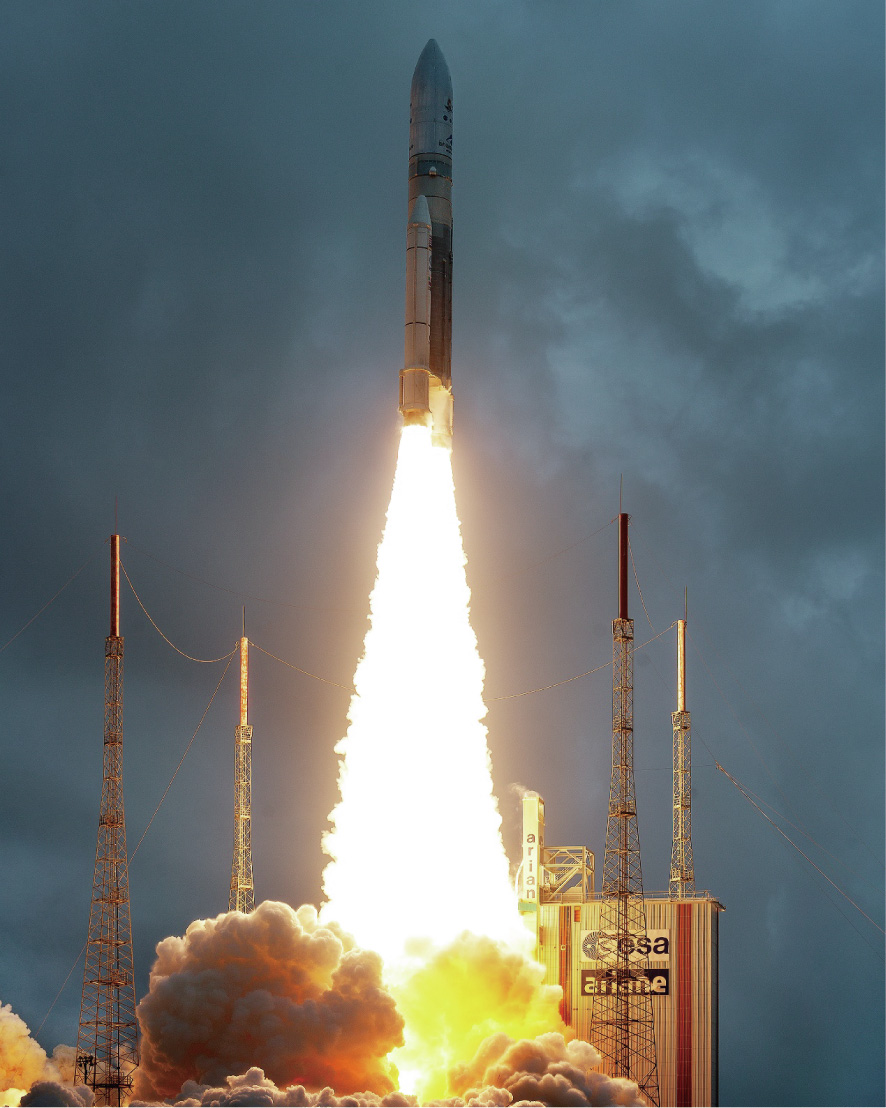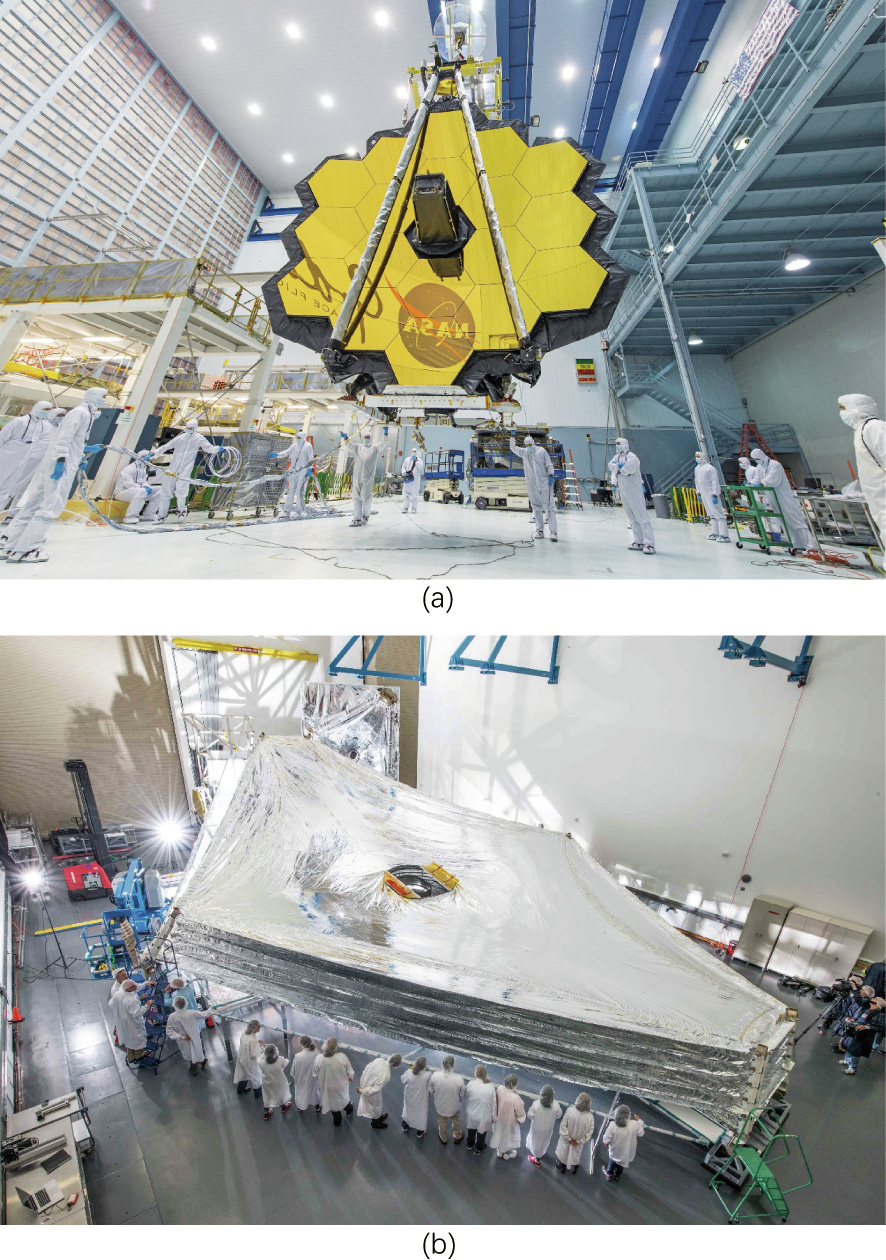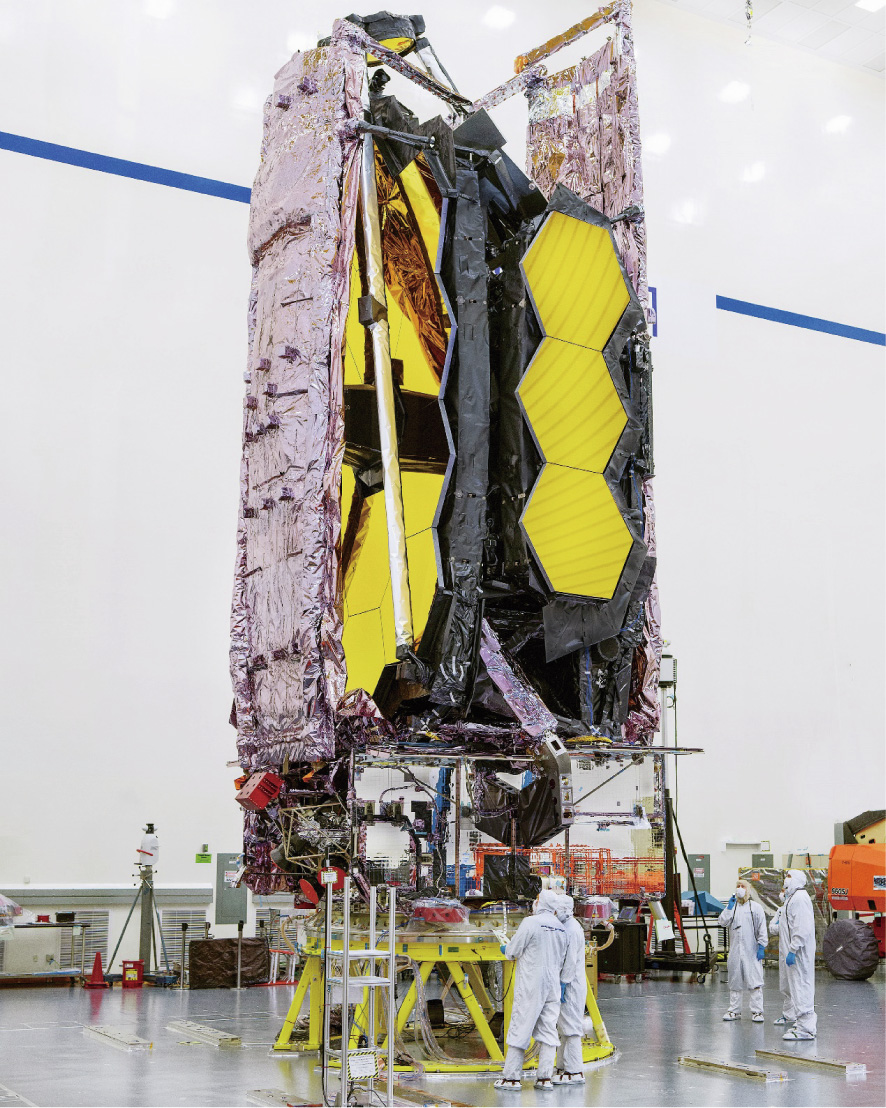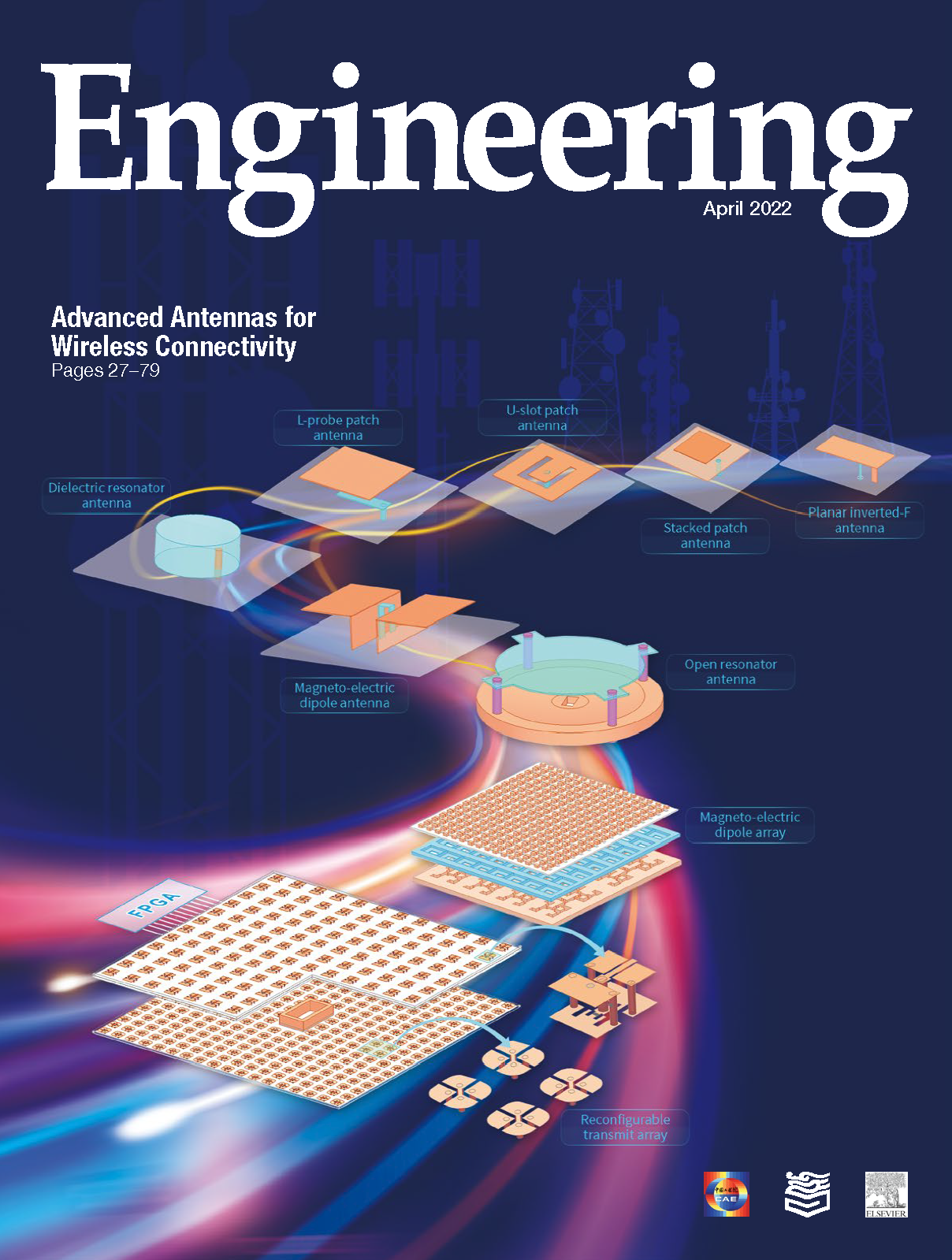Over the last 30 years, the Hubble Space Telescope has revolutionized astronomy and awed the public with gorgeous photos of the cosmos. Scientists expect even bigger achievements from Hubble’s successor, the James Webb Space Telescope (JWST), which blasted off atop an Ariane 5 rocket from the Guiana Space Center in Kourou, French Guiana, on December 25, 2021 (Fig. 1) [1].
《Fig. 1》

Fig. 1. The Ariane 5 rocket carrying the JWST blasts off on December 25, 2021. Despite some glitches in the preceding weeks, the launch went off without a hitch, and the telescope began the journey to its orbital location 1.5 million kilometers from Earth. Credit: NASA/Chris Gunn (CC BY 2.0).
‘‘JWST will be like Hubble on steroids,” said Garth Illingworth, professor of astronomy and astrophysics at the University of California, Santa Cruz, CA, USA. The new telescope’s primary mirror is more than twice the size of Hubble’s and can capture about seven times as much light [1]. Researchers anticipate that JWST will allow them to sight some of the earliest stars and galaxies, more accurately measure how fast the universe is expanding, scan the atmospheres of distant planets for chemical hints of life, and make other neverbefore-possible observations [2,3].
But the project, a joint venture from National Aeronautics and Space Administration (NASA), the European Space Agency, and the Canadian Space Agency, almost did not make it to the launching pad because of cost over-runs and delays [4]. And whether the telescope will work as designed and deliver its scientific payoff remains to be seen. ‘‘It is the most complicated observatory we have ever built—and possibly the most complicated machine we have ever put into space,” said Paul Sutter, research professor of astrophysics at Stony Brook University in New York, USA. Deploying the telescope, which has around 1 million moving parts, and keeping its instruments operating more than a million kilometers from Earth required myriad innovative engineering solutions, some of which could not be tested on the ground [5]. A long list of 344 potential ‘‘single-point failures” could disable the telescope [6]. ‘‘It is risky,” Illingworth acknowledged.
Illingworth was one of the researchers who hatched the idea for a new space telescope about 35 years ago, even before Hubble had left the ground. After mulling a variety of options, including a Moon-based facility, scientists settled on an orbiting infrared telescope with a 6.5 m diameter main mirror. Observing in infrared provides several advantages over using visible light. Because the universe is expanding, the most distant and ancient galaxies are speeding away from Earth so fast that their light shifts into the near-infrared and infrared [7]. ‘‘The early galaxies are so redshifted that it is impossible to see them with Hubble,” said Illingworth. Another benefit is that unlike visible light, infrared radiation can pass through the shrouds of dust that conceal forming planets and stars [8].
JWST’s main mirror consists of 18 hexagonal beryllium panels covered with gold (Fig. 2(a)). The telescope’s designers chose beryllium because it is so light—each panel only weighs about one-tenth as much as a comparable area of Hubble’s main mirror [7]. The gold coating is highly reflective and enables the mirror to direct 98% of the radiation it receives to a secondary mirror, which then steers the light to the telescope’s four instruments [9]. JWST will capture wavelengths from 0.6 to 28 μm, covering a significant part of the infrared region of the electromagnetic spectrum [8]. Hubble’s infrared camera, which astronauts installed after the telescope’s launch, can detect wavelengths up to 2.5 μm, so it is sensitive to a much smaller portion of infrared [8].
《Fig. 2》

Fig. 2. (a) Technicians prepare the telescope’s unfolded main mirror, which is 6.5 m across and weighs 705 kg. (b) The sun shield measures 21 m by 14 m, and its five layers were collapsed at liftoff. Once the telescope was in space, the shield expanded like an accordion to the configuration shown here. Credit: (a) NASA/ Desiree Stover (CC BY 2.0); (b) NASA/Goddard/Chris Gunn (CC BY 2.0).
To discern weak infrared signals traveling through space, JWST needs to be extremely cold—three of its instruments operate optimally at –236 °C, and its mid-infrared instrument (MIRI) must remain below –266 °C [10,11]. That is why JWST will orbit at the second Lagrange point (L2), about 1.5 million kilometers away, instead of a few hundred kilometers above Earth like Hubble [12]. At this distance, heat emanating from Earth does not interfere with the telescope’s observations [7]. ‘‘Space is an incredible refrigerator,” said Illingworth. Compared with Hubble’s close-in orbit, L2 also provides a better vantage point since Earth does not obstruct the spacecraft’s view for part of the day [12].
Even in the refrigerator of space, the Sun will warm JWST. Engineers devised two solutions to lower the telescope’s temperature. The MIRI has its own cryocooler [11]. Cooling the entire telescope is one of the project’s signature engineering innovations—a fivelayer sun shield (Fig. 2(b)) [7]. Each kite-shaped layer is composed of a shiny, heat-resistant film called Kapton that is coated with aluminum [13]. The sun-facing sides of the two outer layers are also covered with treated silicon that reflects sunlight [13]. The five layers, which range from 0.025 to 0.05 mm thick, trap heat and channel some of it into space, providing more protection than would a single layer [13]. As a result, although the sun-facing side of the telescope can reach more than 120 °C, the mirror side remains more than 300 °C cooler [7].
Hubble nearly became one of NASA’s biggest disasters because the telescope’s main mirror was polished incorrectly, a defect not detected before launch because of inadequate testing [14]. JWST underwent more thorough vetting in part because, unlike Hubble, it is too far away to be repaired by astronauts [15]. Professor of physics J.R. Dennison of Utah State University in Logan, UT, USA, and his team spent five years testing many of the telescope’s materials—including carbon fiber composites used in many of its components, the sun shield’s Kapton, and some of the optical coatings for the mirror—to determine how they would fare in space.
In later tests, engineers lifted the assembled mirror with a crane to simulate weightlessness, allowing them to gauge whether the 18 panels—which were folded up during launch (Fig. 3)—could open into the correct shape in space [16]. JWST also passed trials of space-worthiness in NASA’s 37 m tall cryogenic vacuum chamber in Houston, TX, USA, where it endured temperatures as low as –217 °C [7].
《Fig. 3》

Fig. 3. Too large to fit into the fairing of a rocket, the telescope was folded into this smaller arrangement before launch. Credit: NASA/Chris Gunn (CC BY 2.0).
JWST’s complex engineering and exhaustive testing came at a price—and nearly doomed the project. In 1996 NASA projected that the telescope would launch around 2007 and cost 1 billion USD—a figure that experts agree was unrealistically low [17]. As the project’s timeline stretched, its price tag ballooned to the current figure of about 10 billion USD [18]. Dismayed by the soaring costs and delays, in 2011 the United States House of Representatives voted to kill the telescope, only restoring funding after intense lobbying that included a letter-writing campaign by school children [18]. US politicians were not the only critics. An article in the journal Nature dubbed the project ‘‘the telescope that ate astronomy” because it was consuming so much of the field’s money, time, and effort [19]. Sutter also voiced doubts about its value: ‘‘I’m worried that in 50 years, we will look back and say we could have done better things with our time and money.”
Now that JWST has lifted off, researchers hope that it has left the controversies behind. Three days into its mission, the telescope began to deploy its sun shield, which, like its mirror, was folded during launch to fit into the fairing of the Ariane 5 rocket. Scientists were concerned because testing on Earth could not replicate the shield’s behavior in space [7]. But the 107 actuators and 90 cables that had to work in synchrony to extend the structure did their job [20,21]. The two wings of the telescope’s main mirror also locked into place on January 8, 2022, and the craft reached L2 on January 24 [22,23].
Assuming there are no malfunctions, JWST will provide a huge boost to infrared astronomy, said Rodger Thompson, professor of astronomy at the University of Arizona in Tucson, AZ, USA, who was project manager for Hubble’s infrared camera. ‘‘It is big, it is cold, and it can go to so much longer infrared wavelengths than Hubble,” said Thompson. For instance, he noted, JWST might allow scientists to observe light from galaxies that contain the first stars, which began shining around 13.5 billion years ago [24]. So far, astronomers have only been able to detect stars that formed later from the remains of these early stars, he said. ‘‘We think we know what the earliest stars will be like, but we are not sure.”
JWST can see about 500 million years farther back in time than Hubble and resolve objects that formed around 200 million years after the Big Bang [2]. That ability will allow Jeyhan Kartaltepe, associate professor of physics and astronomy at the Rochester Institute of Technology in New York, USA, and colleagues to investigate the formation and evolution of the earliest galaxies. She and her colleagues received the largest allotment of JWST observing time—208 of the roughly 10 000 available hours—to census the galaxies in one area of the sky [25]. Although researchers have glimpsed a few of these ancient galaxies, ‘‘we will be able to look at galaxies farther away in large numbers, so we can do structural analyses,” Kartaltepe said.
JWST could also help astronomers refine their measurements of the Universe’s expansion. Wendy Freedman, professor of astronomy and astrophysics at the University of Chicago in Illinois, IL, USA, and colleagues used Hubble Space Telescope observations of two types of stars, pulsing cepheids and massive red giants, to estimate that the Universe is expanding at around 70 to 72 km·s–1 ·Mpc–1 (Mpc means million parsecs, 1 Mpc = 3.09 × 1022 m) [26,27]. Other studies suggest even higher values of about 74 km·s–1 ·Mpc–1 [26]. However, estimates that rely on measurements of the microwave radiation remaining from the Big Bang yield a rate of about 67 km·s–1 ·Mpc–1 [27]. The disparity is important because the faster rates contradict theoretical predictions and could mean that an unrecognized factor is accelerating the Universe’s expansion [26]. JWST’s greater sensitivity will allow Freedman and her colleagues to take more precise measurements of cepheids and red giants that could resolve the contradiction. The telescope ‘‘opens up a window we have not had,” she said.
These are just a few of the subjects that researchers hope JWST will allow them to explore over its projected 10-year lifespan. ‘‘It is going to be a game changer in so many ways,” said Dennison.













 京公网安备 11010502051620号
京公网安备 11010502051620号




